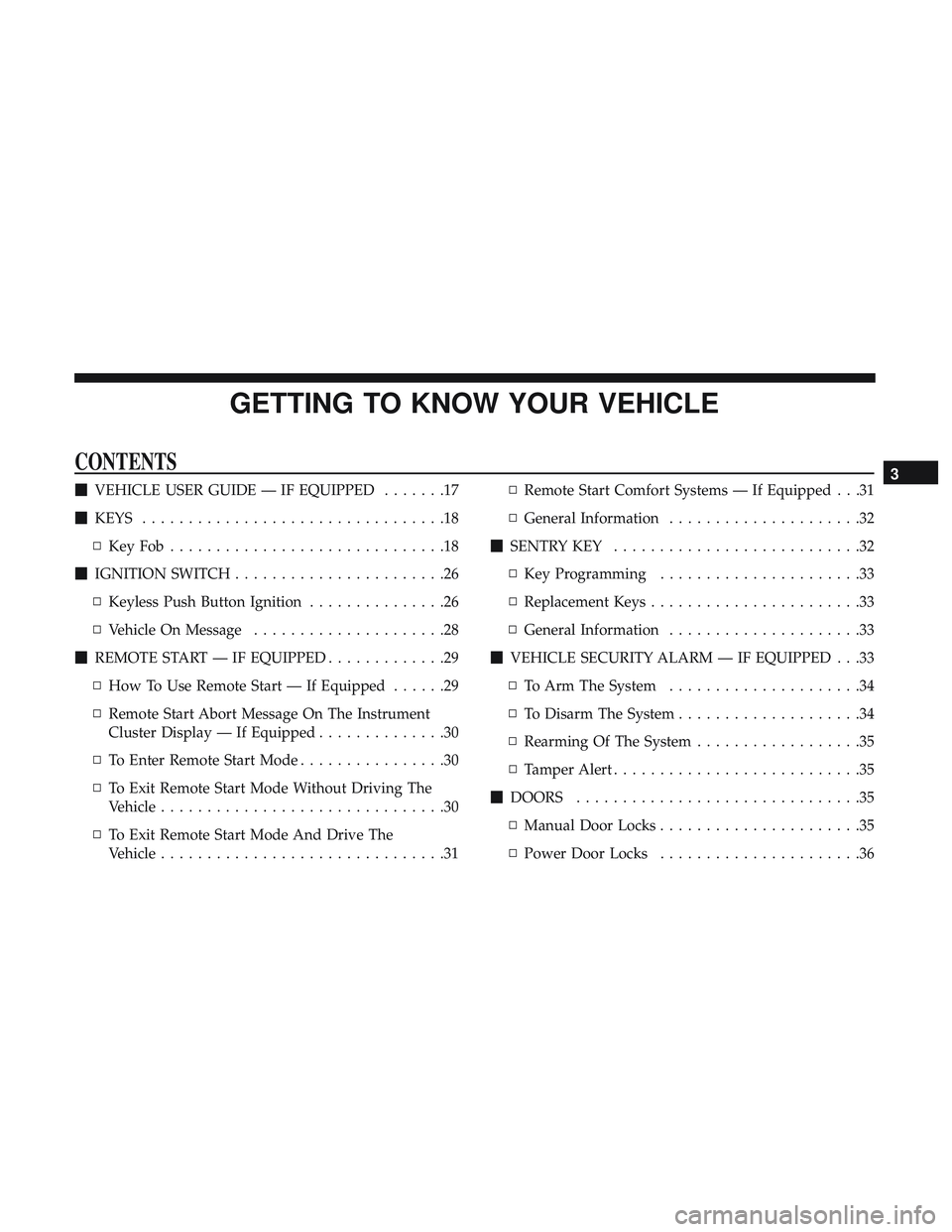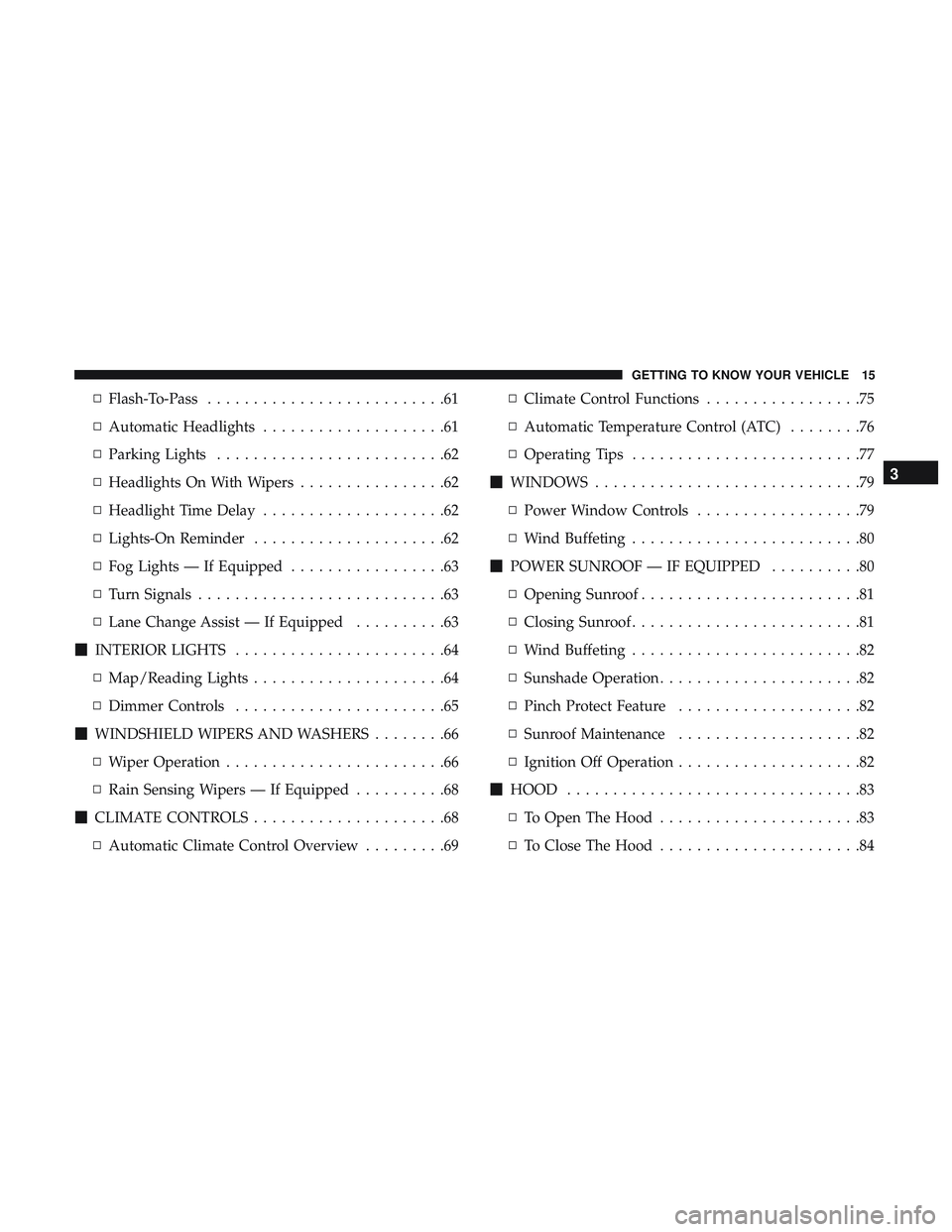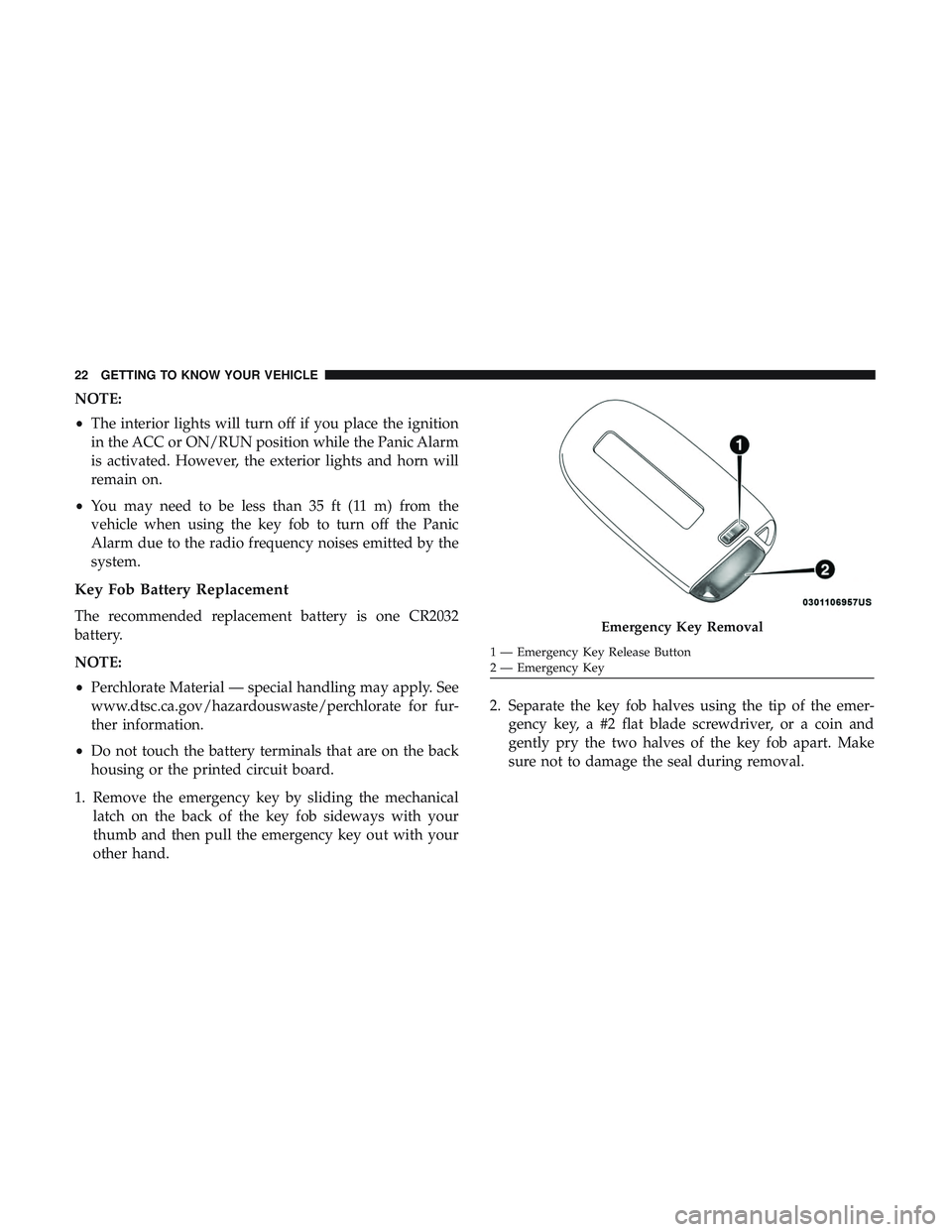Page 12 of 532
INSTRUMENT PANEL
Instrument Panel
1 — Headlight Switch6 — Speed Controls
2 — Instrument Cluster Display Controls 7 — Ignition
3 — Paddle Shifters 8 — Climate Controls
4 — Multifunction Lever (Behind Steering Wheel) 9 — Uconnect System
5 — Instrument Cluster 10 — Switch Panel
10 GRAPHICAL TABLE OF CONTENTS
Page 15 of 532

GETTING TO KNOW YOUR VEHICLE
CONTENTS
�VEHICLE USER GUIDE — IF EQUIPPED .......17
� KEYS .................................18
▫ KeyFob..............................18
� IGNITION SWITCH .......................26
▫ Keyless Push Button Ignition ...............26
▫ Vehicle On Message .....................28
� REMOTE START — IF EQUIPPED .............29
▫ How To Use Remote Start — If Equipped ......29
▫ Remote Start Abort Message On The Instrument
Cluster Display — If Equipped ..............30
▫ To Enter Remote Start Mode ................30
▫ To Exit Remote Start Mode Without Driving The
Vehicle ...............................30
▫ To Exit Remote Start Mode And Drive The
Vehicle ...............................31 ▫
Remote Start Comfort Systems — If Equipped . . .31
▫ General Information .....................32
� SENTRY KEY ...........................32
▫ Key Programming ......................33
▫ Replacement Keys .......................33
▫ General Information .....................33
� VEHICLE SECURITY ALARM — IF EQUIPPED . . .33
▫ To Arm The System .....................34
▫ To Disarm The System ....................34
▫ Rearming Of The System ..................35
▫ Tamper Alert ...........................35
� DOORS ...............................35
▫ Manual Door Locks ......................35
▫ Power Door Locks ......................363
Page 17 of 532

▫Flash-To-Pass ..........................61
▫ Automatic Headlights ....................61
▫ Parking Lights .........................62
▫ Headlights On With Wipers ................62
▫ Headlight Time Delay ....................62
▫ Lights-On Reminder .....................62
▫ Fog Lights — If Equipped .................63
▫ Turn Signals ...........................63
▫ Lane Change Assist — If Equipped ..........63
� INTERIOR LIGHTS .......................64
▫ Map/Reading Lights .....................64
▫ Dimmer Controls .......................65
� WINDSHIELD WIPERS AND WASHERS ........66
▫ Wiper Operation ........................66
▫ Rain Sensing Wipers — If Equipped ..........68
� CLIMATE CONTROLS .....................68
▫ Automatic Climate Control Overview .........69▫
Climate Control Functions .................75
▫ Automatic Temperature Control (ATC) ........76
▫ Operating Tips .........................77
� WINDOWS .............................79
▫ Power Window Controls ..................79
▫ Wind Buffeting .........................80
� POWER SUNROOF — IF EQUIPPED ..........80
▫ Opening Sunroof ........................81
▫ Closing Sunroof .........................81
▫ Wind Buffeting .........................82
▫ Sunshade Operation ......................82
▫ Pinch Protect Feature ....................82
▫ Sunroof Maintenance ....................82
▫ Ignition Off Operation ....................82
� HOOD ................................83
▫ To Open The Hood ......................83
▫ To Close The Hood ......................84
3
GETTING TO KNOW YOUR VEHICLE 15
Page 21 of 532
The emergency key allows for entry into the vehicle should
the battery in the vehicle or the key fob go dead. The
emergency key is also for locking/unlocking the glove
compartment. You can keep the emergency key with you
when valet parking.
To remove the emergency key, slide the mechanical release
button on the back of the key fob sideways with your
thumb and then pull the key out with your other hand.NOTE:
In case the ignition switch does not change with
the push of a button, the key fob may have a low or fully
depleted battery. A low key fob battery can be verified by
referring to the instrument cluster, which will display
directions to follow.
Emergency KeyEmergency Key Removal Process
1 — Mechanical Release Button
2 — Emergency Key
3
GETTING TO KNOW YOUR VEHICLE 19
Page 24 of 532

NOTE:
•The interior lights will turn off if you place the ignition
in the ACC or ON/RUN position while the Panic Alarm
is activated. However, the exterior lights and horn will
remain on.
• You may need to be less than 35 ft (11 m) from the
vehicle when using the key fob to turn off the Panic
Alarm due to the radio frequency noises emitted by the
system.
Key Fob Battery Replacement
The recommended replacement battery is one CR2032
battery.
NOTE:
• Perchlorate Material — special handling may apply. See
www.dtsc.ca.gov/hazardouswaste/perchlorate for fur-
ther information.
• Do not touch the battery terminals that are on the back
housing or the printed circuit board.
1. Remove the emergency key by sliding the mechanical latch on the back of the key fob sideways with your
thumb and then pull the emergency key out with your
other hand. 2. Separate the key fob halves using the tip of the emer-
gency key, a #2 flat blade screwdriver, or a coin and
gently pry the two halves of the key fob apart. Make
sure not to damage the seal during removal.Emergency Key Removal
1 — Emergency Key Release Button
2 — Emergency Key
22 GETTING TO KNOW YOUR VEHICLE
Page 27 of 532

Programming Additional Key Fobs
Programming the key fob may be performed by an autho-
rized dealer.
NOTE:Once a key fob is programmed to a vehicle, it
cannot be repurposed and reprogrammed to another ve-
hicle.
Request For Additional Remote Controls
NOTE: Only key fobs that are programmed to the vehicle
electronics can be used to start and operate the vehicle.
Once a key fob is programmed to a vehicle, it cannot be
programmed to any other vehicle.
WARNING!
• Always remove the key fobs from the vehicle and
lock all doors when leaving the vehicle unattended.
• For vehicles equipped with Keyless Enter-N-Go —
Ignition, always remember to place the ignition in
the OFF mode.
Duplication of key fobs may be performed at an authorized
dealer. This procedure consists of programming a blank
key fob to the vehicle electronics. A blank key fob is one
that has never been programmed. NOTE:
When having the Sentry Key Immobilizer System
serviced, bring all vehicle keys with you to an authorized
dealer.
General Information
The following regulatory statement applies to all radio
frequency (RF) devices equipped in this vehicle:
This device complies with Part 15 of the FCC Rules and
with Industry Canada license-exempt RSS standard(s).
Operation is subject to the following two conditions:
1. This device may not cause harmful interference, and
2. This device must accept any interference received, in- cluding interference that may cause undesired opera-
tion.
NOTE: Changes or modifications not expressly approved
by the party responsible for compliance could void the
user ’s authority to operate the equipment.3
GETTING TO KNOW YOUR VEHICLE 25
Page 28 of 532

IGNITION SWITCH
Keyless Push Button Ignition
This feature allows the driver to operate the ignition with
the push of a button as long as the key fob is in the
passenger compartment.
The Keyless Push Button Ignition has four operating
positions, three of which are labeled and will illuminate
when in position. The three positions are OFF, ACC, and
ON/RUN. The fourth position is START. During start,
ON/RUN will illuminate.
NOTE:If the ignition switch does not change with the
push of a button, the key fob may have a low or dead
battery. In this situation, a back up method can be used to
operate the ignition switch. Put the nose side (side opposite
of the emergency key) of the key fob against the ENGINE
START/STOP button and push to operate the ignition
switch. The push button ignition can be placed in the following
modes:
OFF
•
The engine is stopped.
• Some electrical devices (e.g. central locking, alarm, etc.)
are still available.
START/STOP Ignition Button
1—OFF
2 — ACC
3 — ON/RUN
26 GETTING TO KNOW YOUR VEHICLE
Page 29 of 532

ACC
•Engine is not started.
• Some electrical devices are available.
ON/RUN
• Driving position.
• All the electrical devices are available.
START
• The engine will start.
WARNING!
•When exiting the vehicle, always remove the key fob
from the vehicle and lock your vehicle.
• Never leave children alone in a vehicle, or with
access to an unlocked vehicle.
• Allowing children to be in a vehicle unattended is
dangerous for a number of reasons. A child or others
could be seriously or fatally injured. Children
should be warned not to touch the parking brake,
brake pedal or the gear selector.
(Continued)
WARNING! (Continued)
•Do not leave the key fob in or near the vehicle, or in
a location accessible to children, and do not leave the
ignition of a vehicle equipped with Keyless Enter-
N-Go in the ON/RUN mode. A child could operate
power windows, other controls, or move the vehicle.
• Do not leave children or animals inside parked
vehicles in hot weather. Interior heat build-up may
cause serious injury or death.
CAUTION!
An unlocked vehicle is an invitation for thieves. Al-
ways remove key fob from the vehicle and lock all
doors when leaving the vehicle unattended.
NOTE: Refer to �Starting The Engine,� in�Starting And
Operating� for further information.
3
GETTING TO KNOW YOUR VEHICLE 27